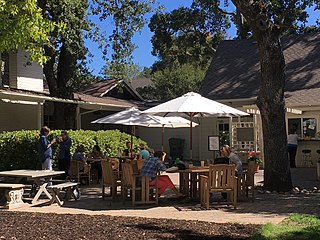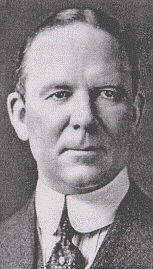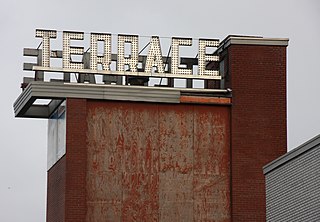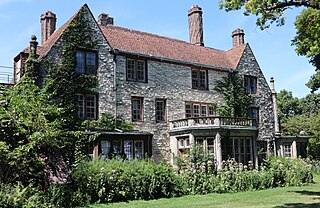
Woodside is a small incorporated town in San Mateo County, California, United States, on the San Francisco Peninsula. It has a council–manager system of government.

North Finchley is a suburb of London in the London Borough of Barnet, situated 7 miles (11 km) north-west of Charing Cross. North Finchley is centred on Tally Ho Corner, the junction of the roads to East Finchley, Church End, Friern Barnet and Whetstone. Church End is often known as Finchley Central, owing to the name of the tube station located there.

The Cathedral of Saint Vibiana, often called St. Vibiana's, is a Catholic former cathedral church of the Archdiocese of Los Angeles. Located in Downtown Los Angeles, the building opened in 1876 as the cathedral for what was then known as the Diocese of Monterey–Los Angeles, and remained the official cathedral of the Los Angeles see for over 100 years.

Glen Abbey Golf Club is a public golf course in Oakville, Ontario, Canada. It is one of Canada's most famous golf courses and is home to the Golf Canada and the Canadian Golf Hall of Fame. It has hosted 30 Canadian Open Championships, more than any other course, with the first having been in 1977. It was the first solo design by Jack Nicklaus in 1976.

The Ontario Heritage Act, first enacted on March 5, 1975, allows municipalities and the provincial government to designate individual properties and districts in the Canadian Province of Ontario, as being of cultural heritage value or interest.

Daniel Cowan Jackling , was an American mining and metallurgical engineer who pioneered the exploitation of low-grade porphyry copper ores at the Bingham Canyon Mine, Utah.

George Washington Smith was an American architect and painter. He is known particularly for his work around Santa Barbara, California, and for popularizing the Spanish Colonial Revival style in early 20th Century America. His notable works include Casa del Herrero, the Lobero Theater, the Santa Barbara News-Press building, and buildings at the Santa Barbara Cemetery. He also designed several private houses in Montecito.

Demolition of Palestinian property is a method Israel has used in the Israeli-occupied territories since they came under its control in the Six-Day War to achieve various aims. Broadly speaking, demolitions can be classified as either administrative, punitive/dissuasive and as part of military operations. The Israeli Committee Against House Demolitions estimated that Israel had razed 55,048 Palestinian structures as of 2022. Administrative house demolitions are done to enforce building codes and regulations, which in the occupied Palestinian territories are set by the Israeli military. Critics claim that they are used as a means to Judaize parts of the occupied territory, especially East Jerusalem. Punitive house demolitions involve demolishing houses of Palestinians or neighbors and relatives of Palestinians suspected of violent acts against Israelis. These target the homes where the suspects live. Proponents of the method claim that it deters violence while critics claim that it has not been proven effective and might even trigger more violence. Punitive house demolitions have been criticized by a Palestinian human rights organization as a form of collective punishment and thus a war crime under international law.
Overdale was a small residential district in downtown Montreal that became a famous symbol of the struggle between urban conservationists and land developers.

Belton Court is a historic estate on Middle Highway in Barrington, Rhode Island. The mansion was built for Frederick Stanhope Peck, a businessman, socialite, and Rhode Island political figure. Later in the twentieth century, the mansion and surrounding property served as the campus for Barrington College and the Zion Bible Institute.

The Guy C. Barton House was a very elaborate and expensive Victorian home in the Midtown area of Omaha, Nebraska, United States, a home and entertaining center of an industrialist and philanthropist. The house caught fire and was demolished in 1982.

Le Fanu House is a large Federation Queen Anne style single-storey home located in Salvado Street, Cottesloe, Western Australia. It was built circa 1893, and is regarded as an example of a grand beachside home.
TWC Enterprises Limited operates ClubLink One Membership More Golf. It is based in King City, Ontario, and is listed on the Toronto Stock Exchange (TSX) with the symbol "TWC".

The destruction of country houses in 20th-century Britain was the result of a change in social conditions: many country houses of varying architectural merit were demolished by their owners. Collectively termed by several authors "the lost houses", the destruction of these now often-forgotten houses has been described as a cultural tragedy.
The San Buenaventura Conservancy for Preservation is an historic preservation organization in Ventura, California also known by its early name of San Buenaventura. It works to recognize and revitalize historic, archeological and cultural resources in the region. The Conservancy is a non-profit 501c3 organization. The group was formed in 2004 after the demolition of the Mayfair Theater, an S. Charles Lee, Streamline Moderne, movie theater in downtown Ventura, California that was razed and replaced with a condominium project.

Lincoln Place Apartment Homes is a historic apartment community owned by a subsidiary of Apartment Investment and Management Co. (Aimco). Inspired by the garden city movement, it is located at 1050 Frederick Street on a 35-acre site in the Venice community of Los Angeles, one mile east of Venice Beach. Built from 1949-1951, the property is just off Lincoln Boulevard, bound by Lake Street and Penmar Avenue with Elkgrove Avenue and Elkgrove Circle within its interior.

McLean's Mansion is a homestead in Christchurch, New Zealand. The two hectares property is situated between Manchester and Colombo Streets. The mansion was initially known as 'Holly Lea', but later became known as McLean's Mansion after its initial owner. It is the largest wooden residence in New Zealand. The mansion, designed by Robert England, architect of Christchurch, is a fusion of styles of Jacobean architecture and Victorian features, akin to the Mentmore Towers (1852–54) of Sir Joseph Paxton in Buckinghamshire in England. It was built between April 1899 and September 1900. The house is registered as a Category I heritage building by Heritage New Zealand. After the 2011 Christchurch earthquake, the owners applied to demolish the earthquake-damaged buildings, but their request was denied by the heritage body and the courts. In December 2016, the building sold to a trust that will restore it for use as a gallery. Restoration is expected to be finished by 2024.

The Terrace Theatre was located at 3508 France Avenue North in Robbinsdale, Minnesota. Upon its opening on May 23, 1951, the Terrace received critical acclaim for its “bold architectural lines [and] extensive patron services.” The 1,299-seat theater, designed in the mid-century modern style by the Minneapolis architectural firm of Liebenberg & Kaplan (L&K) for movie exhibitors Sidney and William Volk, was a popular Twin Cities destination for nearly fifty years. It changed hands in 1980 and again in 1987, when it was remodeled from a single-screen auditorium into three screens by dividing the balcony. The last movie was screened in 1999 and the theater remained boarded up for seventeen years before it was demolished in the fall of 2016 to be replaced by a Hy-Vee grocery store.

The Harley Clarke Mansion consists of a French Eclectic-style house and coach house located at 2603 Sheridan Road in Evanston, Illinois, adjacent to the historic Grosse Pointe Light and Lighthouse Beach on Lake Michigan. Cited as a contributing structure for the Northeast Evanston Historic District that Evanston established with the National Park Service in 1999, it is listed on the National Register of Historic Places.


















